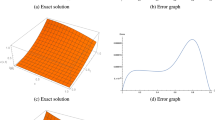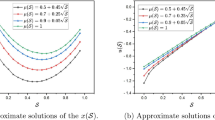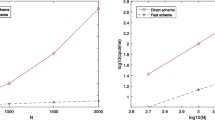Abstract
In this study, iterative reproducing kernel method (RKM) will be applied in order to observe the effect of the method on numerical solutions of fractional order Boussinesq equation. Hilbert spaces and their kernel functions, linear operators and base functions which are necessary to obtain the reproducing kernel function are clearly explained. Iterative solution is constituted in a serial form by using reproducing kernel function. Then convergence of RKM solution is shown with lemma and theorem. Two problems, “good” Boussinesq and generalized Boussinesq equations, are examined by using RKM for different fractional values. Results are presented with tables and graphics.




Similar content being viewed by others
References
Boussinesq, M.: Théorie générale des mouvements qui sout propagés dans un canal rectangularire horizontal. C. R. Acad. Sci. Paris 73, 256–260 (1871)
Boussinesq, M.: Théorie des ondes et des remous qui se propagent le long d’un canal rectangulaire horizontal, en communiquant au liquide contenu dans ce canal des vitesses sensiblement pareilles de la surface au fond. J. Math. Pure Appl. Sect. 17, 55–108 (1872)
Boussinesq, M.: Essai sur la théorie des eaux courantes, Mémoires présentés par divers savants á l’Académie des Sciences Inst. France, pp. 1-680 (1877)
Kalantorov, V.K., Ladyzhenskaya, O.A.: The occurence of collapse for quailinear equation of parabolic and hyperbolic types. J. Soviet Math. 10, 53–70 (1978)
Lin, Q., Wu, Y.H., Loxton, R.: On the Cauchy problem for a generalized Boussinesq equation. J. Math. Anal. Appl. 353, 186–195 (2009)
Xue, R.: The initial-boundary value problem for the “good” Boussinesq equation on the bounded domain. J. Math. Anal. Appl. 343, 975–995 (2008)
Brugnano, L., Gurioli, G., Zhang, C.: Spectrally accurate energy-preserving methods for the numerical solution of the “good” Boussinesq equation. Numer. Methods Partial Differ. Equ. 35, 1343–1362 (2019)
Manoranjan, V.S., Mitchell, A.R., Morris, J.L.: Numerical solutions of the good Boussinesq equation. SIAM J. Sci. Stat. Comput. 5, 946–957 (1984)
Manoranjan, V.S., Ortega, T., Sanz-Serna, J.M.: Soliton and antisoliton interactions in the “good” Boussinesq equation. J. Math. Phys. 29, 1964–1968 (1988)
Nguyen, L.T.K.: Soliton solution of good Boussinesq equation. Vietnam J. Math. 44, 375–385 (2016)
Yan, J., Zhang, Z., Zhao, T., Liang, D.: High-order energy-preserving schemes for the improved Boussinesq equation. Numer. Methods Partial Differ. Equ. 34, 1145–1165 (2018)
Cheng, K., Feng, W., Gottlieb, S., Wang, C.: A Fourier pseudospectral method for the “good” Boussinesq equation with second-order temporal accuracy. Numer. Methods Partial Differ. Equ. 31, 202–224 (2015)
Bratsos, A.G.: Solitary-wave propagation and interactions for the “good” Boussinesq equation. Int. J. Comput. Math. 85, 143–1440 (2008)
El-Zoheiry, H.: Numerical investigation for the solitary waves interaction of the “good” Boussinesq equation. Appl. Numer. Math. 45, 161–173 (2003)
Karaagac, B., Ucar, Y., Esen, A.: Numerical solutions of the improved Boussinesq equation by the Galerkin quadratic B-spline finite element method. Filomat 32, 5573–5583 (2018)
Zaremba, S.: Sur le calcul numérique des fonctions demandées dans le probléme de Dirichlet et le problème hydrodynamique. Bulletin International de l’Académie des Sciences de Cracovie, pp. 125–195 (1908)
Aronszajn, N.: Theory of reproducing kernels. Trans. Am. Math. Soc. 68, 337–404 (1950)
Schwartz, L.: Sous-espaces hilbertiens d’espaces vectoriels topologiques et noyaux associés (noyaux reproduisants). J. Anal. Math. 13, 115–256 (1964)
Saitoh, S., Sawano, Y.: Theory of reproducing kernels and applications. pp. 1–452. Springer, Singapore (2016)
Cui, M.G., Lin, Y.Z.: Nonlinear Numercial Analysis in the Reproducing Kernel Space, pp. 1–226. Nova Science Publisher, New York (2009)
Al-Smadi, M., Abu Arqub, O.: Computational algorithm for solving fredholm time-fractional partial integrodifferential equations of Dirichlet functions type with error estimates. Appl. Math. Comput. 342, 280–294 (2019)
Abu Arqub, O., Odibat, Z., Al-Smadi, M.: Numerical solutions of time-fractional partial integrodifferential equations of Robin functions types in Hilbert space with error bounds and error estimates. Nonlinear Dyn. 94, 1819–1834 (2018)
Yao, H.: Reproducing Kernel method for the solution of nonlinear hyperbolic telegraph equation with an integral condition. Numer. Methods Partial Differ. Equ. 27, 867–886 (2011)
Wang, Y., Du, M., Tan, F., Li, Z., Nie, T.: Using reproducing kernel for solving a class of fractional partial differential equation with non-classical conditions. Appl. Math. Comput. 219, 5918–5925 (2013)
Sakar, M.G., Akgül, A., Baleanu, D.: On solutions of fractional Riccati differential equations. Adv. Diff. Equ. 39, 1–10 (2017)
Abu Arqub, O.: Fitted reproducing kernel Hilbert space method for the solutions of some certain classes of time-fractional partial differential equations subject to initial and Neumann boundary conditions. Comput. Math. Appl. 73, 1243–1261 (2017)
Jiang, W., Lin, Y.: Representation of exact solution for the time-fractional telegraph equation in the reproducing kernel space. Commun. Nonlinear Sci. Numer. Simul. 16, 3639–3645 (2011)
Mohammadi, M., Mokhtari, R., Panahipour, H.: A Galerkin-reproducing kernel method: application to the 2D nonlinear coupled Burgers equations. Eng. Anal. Bound. Elem. 37, 1642–1652 (2013)
Abu Arqub, O., Al-Smadi, M.: Numerical algorithm for solving time-fractional partial integro differential equations subject to initial and Dirichlet boundary conditions. Numer. Methods Partial Differ. Equ. 34, 1577–1597 (2018)
Sakar, M.G., Saldır, O., Erdogan, F.: An iterative approximation for time-fractional Cahn-Allen equation with reproducing kernel method. Comput. Appl. Math. 37, 5951–5964 (2018)
Sakar, M.G., Saldır, O., Akgül, A.: A novel technique for fractional Bagley-Torvik equation. Proc. Natl. Acad. Sci. India Sect. A Phys. Sci. 89, 539–545 (2019)
Saldır, O., Sakar, M.G., Erdogan, F.: Numerical solution of time-fractional Kawahara equation using reproducing kernel method with error estimate. Comput. Appl. Math. 198, 1–23 (2019)
Sakar, M.G., Saldır, O., Erdogan, F.: A hybrid method for singularly perturbed convection–diffusion equation. Int. J. Appl. Comput. Math. 135, 1–17 (2019)
Podlubny, I.: Fractional Differential Equations, pp. 1–340. Academic Press, New York (1999)
Diethelm, K.: The Analysis of Fractional Differential Equations. Lecture Notes in Mathematics, pp. 1–247. Springer, Berlin (2010)
Arqub, O.A., Maayah, B.: Fitted fractional reproducing kernel algorithm for the numerical solutions of ABC-Fractional Volterra integro-differential equations. Chaos Solitons Fractals 126, 394–402 (2019)
Arqub, O.A.: Numerical simulation of time-fractional partial differential equations arising in fluid flows via reproducing kernel method. Int. J. Numer. Methods Heat Fluid Flow 29, 1–23 (2019)
Arqub, O.A.: Numerical solutions of systems of first-order, two-point BVPs based on the reproducing kernel algorithm. Calcolo 55, 1–28 (2018)
Yang, H.: Homotopy analysis method for the time-fractional Boussinesq equation. Univ. J. Math. Appl. 3, 12–18 (2020)
Zhang, H., Jiang, X., Zhao, M., Zheng, R.: Spectral method for solving the time fractional Boussinesq equation. Appl. Math. Lett. 85, 164–170 (2018)
Qi, W.: Numerical solutions of fractional Boussinesq equation. Commun. Theor. Phys. 47, 413–420 (2019)
Author information
Authors and Affiliations
Corresponding author
Additional information
Publisher's Note
Springer Nature remains neutral with regard to jurisdictional claims in published maps and institutional affiliations.
Appendix
Appendix
In this part, the general definition and inner product of \(W_{2}^{n}[0,1]\) will be given. Definition of \(W_{2}^{5}\) and \(W_{2}^{3}\) spaces and their kernel functions will be presented for obtaining reproducing kernel function of \(W_{2}^{(5,3)}(\varOmega )\). Then, it will be explained how to obtain the kernel functions of \(W_{2}^{(1,1)}(\varOmega )\) and \(W_{2}^{(5,3)}(\varOmega )\) spaces.
\(\mathbf {W}_{2}^{n}[0,1]\) space and its kernel function
\(W_{2}^{n} \left[ {0,\,1} \right] \) space is described as
Inner product of \(W_{2}^{n} \left[ {0,\,1} \right] \) can be written as:
and norm of \(W_{2}^{n} \left[ {0,\,1} \right] \) is given as follow:
It will be given some kernel functions for different initial-boundary conditions and special cases.
Case I: \(n=1\);
and
Case II: \(n=3\) and \(w(0)={w}'(0)=0\)
For \(\zeta \le z\), the kernel function \(K_z^{\{3\}}(\zeta )\) is given as:
Case III: \(n=5\) and \(w(0)=w(1)={w}''(0)={w}''(1)=0\)
For \(\eta \le y\), the kernel function \(K_y^{\{5\}}(\eta )\) is given as:
For obtaining of coefficients \(c_i(y)\) and \(d_i(y)\), please see [20].
Note: The reproducing kernel function of \(W_{2}^{(5,3)}(\varOmega )\) is found by multiplying of kernel functions \(K_z^{\{3\}}(\zeta )\) and \(K_y^{\{5\}}(\eta )\). Similarly, the kernel function of \(W_{2}^{(1,1)}(\varOmega )\) is found by multiplying of kernel functions \(K_z^{\{1\}}(\zeta )\) and \(K_y^{\{1\}}(\eta )\).
Rights and permissions
About this article
Cite this article
Sakar, M.G., Saldır, O. A novel iterative solution for time-fractional Boussinesq equation by reproducing kernel method. J. Appl. Math. Comput. 64, 227–254 (2020). https://doi.org/10.1007/s12190-020-01353-4
Received:
Published:
Issue Date:
DOI: https://doi.org/10.1007/s12190-020-01353-4




